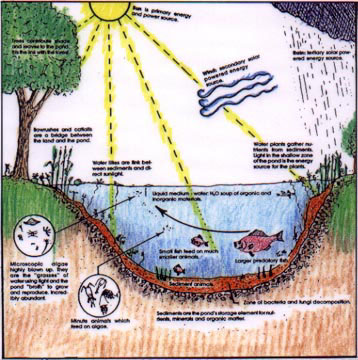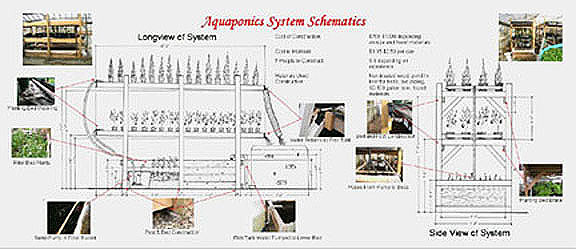How does aquaponics work?
 In a natural pond, fish consume food and excrete waste.
Bacteria convert the toxic ammonia in fish waste into nitrate;
a nutrient for plants.
In a natural pond, fish consume food and excrete waste.
Bacteria convert the toxic ammonia in fish waste into nitrate;
a nutrient for plants.
The raw organic matter in the fish feces and old plants are transformed
by microbes, insects and earthworms into humus; the heart of living
soil. Humus is the best fertilizer there is for organic vegetables.
 Organic aquaponics harnesses the
relationships of natural ecosystems, combining:
* Soil, Earthworms and Microorganisms,
Organic aquaponics harnesses the
relationships of natural ecosystems, combining:
* Soil, Earthworms and Microorganisms,
* Water, Fish and Microorganisms,
* Plants, Seeds, Sunlight and Air, and *People
' Their making more people every day, but they ain't
making more dirt'
As our global population grows, people have forgotten
how to work with nature to recycle waste, and have forgotten how
to return their fooscraps back to the land through composting.
100 years ago half of the people lived on the land and were farmers.
Today only 3% of people farm or garden. Ecological farming offers
a life-sustaining solution to overpopulation, by restoring the
ecological relations between people, fish, animals and plant and
microbes. Even in a city, anyone can live ecologically by composting
their foodscraps, and growing a garden and fish pond in their
backyard or rooftop
Aquaponics is a farming method inspired by ancient
farming systems from the Aztecs to Egypt, based on the recycling
of nutrients in nature. In the aquaponic fish tank,, the fish
consume food and excrete manure, algea grows in the nutrient-rich
water, and uneaten fish food falls to the bottom. These unused
nutrients would build-up and contaminate the fish tank, but instead
are recycled as a liquid fertilizer for plants. The plants are
a natural biofilter for the fish waste. Beneficial bacteria in
the gravel and on the roots have a key role by recycling the wasted
nutrients into food absorbed by the plants, while cleansing and
purify the water. Wthout these microorganisms the whole system
would stop functioning. Uneaten food and foodscraps from people
are also recycled back into the system. Earthworms metabolize
the fish waste solids, old plants and food scraps from your table.
The waste products of each organism, fish, plants and people,
becomes food for another in a continuous cycle of life. There
is no waste and no pollution.
Basic Principles:
1. Complex biological diversity integrating
sunlight, fish, plants and earthworms with ecological niches for
beneficial microbial activity, the heart of the aquaponic foodweb.
2. Nutrient cycling occurs through
biological water filtration that transforms
waste nutrients from fish and converts it into a usable form for
plant uptake.
Red wiggler earthworms metabolize foodscraps
and plant matter, producing fertile, vermicompost that suppresses
disease in the plant trough and fish pond.
Duckweed and algea use the remaining
nitrogen in the fish wastewater and convert it into a protein-rich
plant food for the Tilapia fish.
3. People are a key species in the 'total aquaponic
ecosystem'. We contribute the waste products of
human ecologies, such as foodscraps or greywater, and our caring
energy. The aquaponic products of fish, organic vegetables, ornamental
plants, duckweed, earthworms, vermicompost, plus new knowledge
and skills, generate income which supports a local economy
within an urban greenhouse foodweb.


